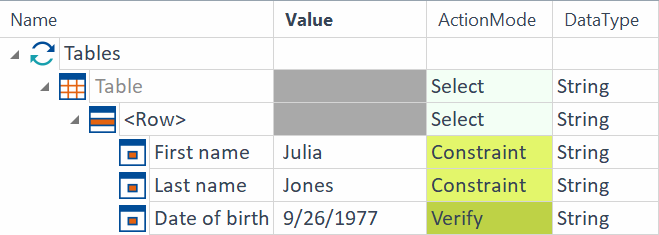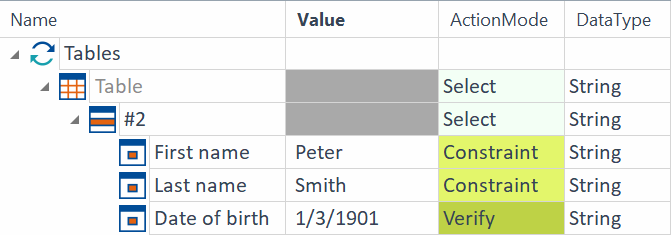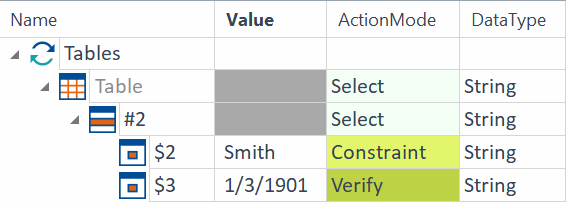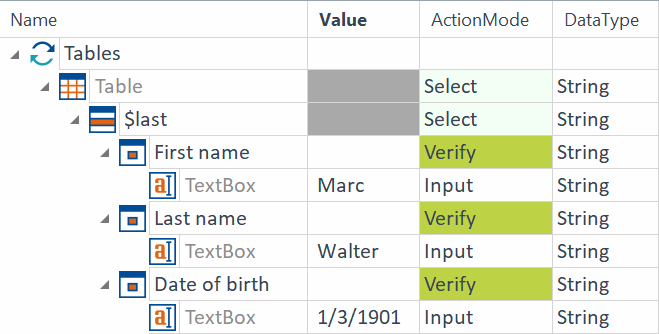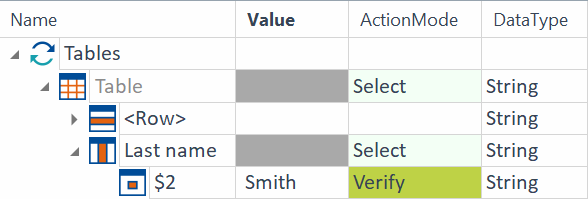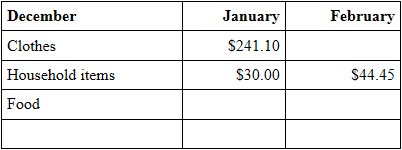Table steering examples
The following examples refer to the table below containing simple personal data. The last row does not contain any data, and each cell of this row contains an embedded textbox.

Table containing personal data
For detailed information on table steering, see chapter "Table".
Example 1 - Selecting a row with a fixed position

|
In a table, row 3 is selected. We will now verify whether the value Jones exists in the column Last name of this row.
Verifying the value of a cell You can also use the property Text to verify cell values:
Verifying a cell value by using the property Text |
Example 2 - Selecting rows by using values in specific cells

|
A row, which has the attribute First name including the value Julia and the attribute Last name including the value Jones, is searched for in a table. In the row which contains these values, the engine should verify whether the attribute Date of birth including the value 9/26/1977 exists.
Verifying a value |
Example 3 - Selecting a row by value

|
A cell, which contains the value 10/5/1966, should be searched in a table. In the row that contains this value, the engine verifies whether the attribute First name contains the value Jane and whether Last name contains the value Miller.
Verifying values |
Example 4 - Selecting a specific row when there are several equal entries

|
In the table, the second row with the attribute First name including the value Peter and the attribute Last name including the value Smith, is searched for. The value #2 has to be entered for the selection. In this row, the engine should verify whether the attribute Date of birth has the value 1/3/1901.
Verifying values 2 |
Example 5 - Selecting a cell by Index

|
In the table, find the second row with the value Smith in the second cell. The value #2 indicates the second occurrence. In this row, the engine should verify whether cell 3 has the value 1/3/1901.
Verifying values 3 |
Example 6 - Selecting the last row and entering values into embedded controls

|
The engine searches for the last row of the table using the $last syntax. The attributes First name including the value Marc, Last name including the value Walker and Date of birth including the value 12/24/1980, should be entered in this row. Each one of these cells contains an embedded textbox.
Entering values into the last row |
Example 7 - Verifying the number of rows

|
The property RowCount is used to verify whether a table has 7 rows. The header is included in the search query.
Verifying the number of rows |
Example 8 - Selecting the cell of a column

|
The engine verifies whether the value Smith exists in row 2 of the Last name column.
Verifying a value |
Example 9 - Saving the value of a cell to a buffer

|
The value that is located in the fourth row of the Last name column is written to the buffer Buffer1.
Buffering values in Buffer1 |
Example 10 - Steering controls with decisive columns

|
The system performs a click into a cell by using the table below.
Sample table FirstEmptyRow The column February is defined as decisive for control steering (decisive column). As a result, the system searches the February column for the first empty cell, and it clicks into the cell containing the value $241.10 of the same row in the January column.
FirstEmptyRow LastContentRow The column February is defined as decisive for control steering (decisive column). As a result, the system searches the February column for the last cell that includes a value, and it clicks into the cell containing the value $30.00 of the same row in the January column.
LastContentRow Defining several decisive columns If several decisive columns exist in a workspace, the FirstEmptyRow columns are linked with a logical AND, and the LastContentRow columns with a logical OR. The January and February columns are defined decisive for control steering. In row 3, both columns are empty. Therefore, the system clicks into the cell containing the value Food of the December column.
FirstEmptyRow with multiple decisive columns |
Example 11 - Buffering the row number

|
You can use the RowNumber property to find the row number of the table where a defined value is located. Define a value from your table's first column. In this example, the engine writes the row number of the value Julia into the Buffer_row_number. The result is 3.
Buffering row number values |


